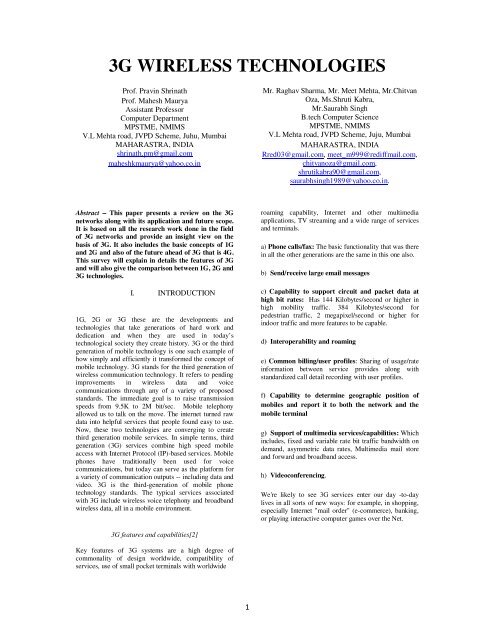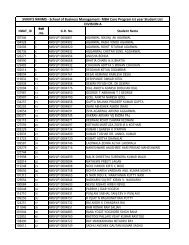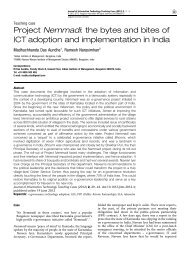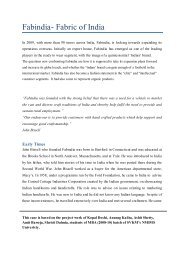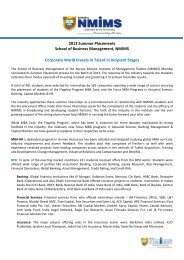3G WIRELESS TECHNOLOGIES - NMIMS
3G WIRELESS TECHNOLOGIES - NMIMS
3G WIRELESS TECHNOLOGIES - NMIMS
You also want an ePaper? Increase the reach of your titles
YUMPU automatically turns print PDFs into web optimized ePapers that Google loves.
<strong>3G</strong> <strong>WIRELESS</strong> <strong>TECHNOLOGIES</strong><br />
Prof. Pravin Shrinath<br />
Prof. Mahesh Maurya<br />
Assistant Professor<br />
Computer Department<br />
MPSTME, <strong>NMIMS</strong><br />
V.L Mehta road, JVPD Scheme, Juhu, Mumbai<br />
MAHARASTRA, INDIA<br />
shrinath.pm@gmail.com<br />
maheshkmaurya@yahoo.co.in<br />
Abstract – This paper presents a review on the <strong>3G</strong><br />
networks along with its application and future scope.<br />
It is based on all the research work done in the field<br />
of <strong>3G</strong> networks and provide an insight view on the<br />
basis of <strong>3G</strong>. It also includes the basic concepts of 1G<br />
and 2G and also of the future ahead of <strong>3G</strong> that is 4G.<br />
This survey will explain in details the features of <strong>3G</strong><br />
and will also give the comparison between 1G, 2G and<br />
<strong>3G</strong> technologies.<br />
I. INTRODUCTION<br />
1G, 2G or <strong>3G</strong> these are the developments and<br />
technologies that take generations of hard work and<br />
dedication and when they are used in today’s<br />
technological society they create history. <strong>3G</strong> or the third<br />
generation of mobile technology is one such example of<br />
how simply and efficiently it transformed the concept of<br />
mobile technology. <strong>3G</strong> stands for the third generation of<br />
wireless communication technology. It refers to pending<br />
improvements in wireless data and voice<br />
communications through any of a variety of proposed<br />
standards. The immediate goal is to raise transmission<br />
speeds from 9.5K to 2M bit/sec. Mobile telephony<br />
allowed us to talk on the move. The internet turned raw<br />
data into helpful services that people found easy to use.<br />
Now, these two technologies are converging to create<br />
third generation mobile services. In simple terms, third<br />
generation (<strong>3G</strong>) services combine high speed mobile<br />
access with Internet Protocol (IP)-based services. Mobile<br />
phones have traditionally been used for voice<br />
communications, but today can serve as the platform for<br />
a variety of communication outputs -- including data and<br />
video. <strong>3G</strong> is the third-generation of mobile phone<br />
technology standards. The typical services associated<br />
with <strong>3G</strong> include wireless voice telephony and broadband<br />
wireless data, all in a mobile environment.<br />
<strong>3G</strong> features and capabilities[2]<br />
Key features of <strong>3G</strong> systems are a high degree of<br />
commonality of design worldwide, compatibility of<br />
services, use of small pocket terminals with worldwide<br />
1<br />
Mr. Raghav Sharma, Mr. Meet Mehta, Mr.Chitvan<br />
Oza, Ms.Shruti Kabra,<br />
Mr.Saurabh Singh<br />
B.tech Computer Science<br />
MPSTME, <strong>NMIMS</strong><br />
V.L Mehta road, JVPD Scheme, Juju, Mumbai<br />
MAHARASTRA, INDIA<br />
Rred03@gmail.com, meet_m999@rediffmail.com,<br />
chitvanoza@gmail.com,<br />
shrutikabra90@gmail.com,<br />
saurabhsingh1989@yahoo.co.in.<br />
roaming capability, Internet and other multimedia<br />
applications, TV streaming and a wide range of services<br />
and terminals.<br />
a) Phone calls/fax: The basic functionality that was there<br />
in all the other generations are the same in this one also.<br />
b) Send/receive large email messages<br />
c) Capability to support circuit and packet data at<br />
high bit rates: Has 144 Kilobytes/second or higher in<br />
high mobility traffic. 384 Kilobytes/second for<br />
pedestrian traffic, 2 megapixel/second or higher for<br />
indoor traffic and more features to be capable.<br />
d) Interoperability and roaming<br />
e) Common billing/user profiles: Sharing of usage/rate<br />
information between service provides along with<br />
standardized call detail recording with user profiles.<br />
f) Capability to determine geographic position of<br />
mobiles and report it to both the network and the<br />
mobile terminal<br />
g) Support of multimedia services/capabilities: Which<br />
includes, fixed and variable rate bit traffic bandwidth on<br />
demand, asymmetric data rates, Multimedia mail store<br />
and forward and broadband access.<br />
h) Videoconferencing.<br />
We're likely to see <strong>3G</strong> services enter our day -to-day<br />
lives in all sorts of new ways: for example, in shopping,<br />
especially Internet "mail order" (e-commerce), banking,<br />
or playing interactive computer games over the Net.
Drivers of <strong>3G</strong> Adaptation[3]<br />
1. Consumer demand for more robust wireless<br />
data services.<br />
To increase the voice revenues and the overall revenues<br />
the mobile service providers are relying heavily on the<br />
expansion of <strong>3G</strong> technology worldwide. With various<br />
feature like Mobile video, music downloads, e-mail,<br />
messaging, location-based services and Internet surfing,<br />
revenues will automatically increase and be beneficial<br />
for the mobile providers.<br />
2. Upgrading infrastructure investment<br />
The faster <strong>3G</strong> networks are deployed, the faster <strong>3G</strong><br />
adoption rates will rise. Upgrading legacy networks to<br />
accommodate <strong>3G</strong> technology is very costly. In the<br />
United States alone, Verizon Wireless, Sprint Nextel (S)<br />
and Cingular have spent a combined $10 billion on<br />
building their <strong>3G</strong> networks. The carriers that can spend<br />
this kind of money will gain a competitive advantage<br />
over those that can't.<br />
3. <strong>3G</strong> spectrum licensing fees<br />
Spectrum refers to the frequency to carry the data<br />
wirelessly, so it is very obvious that once a bigger market<br />
has been developed for the <strong>3G</strong> technology its spectrum<br />
licensing fees would require a even bigger investment<br />
and will have new standards to be set and followed.<br />
Recently, mobile operators have had to pay phenomenal<br />
rents in auctions for <strong>3G</strong> spectrum licenses. High license<br />
acquisition costs are limiting the number of carriers that<br />
can participate in <strong>3G</strong>.<br />
4. Technology maturity.<br />
For this type of advanced technology to reach to the<br />
world and have a successful base a highly mature<br />
approach is to be followed. The key to investors,<br />
therefore, is to understand and appreciate the<br />
complexities of each <strong>3G</strong> technology and the progress that<br />
the various companies are making towards mainstream<br />
adoption. Be it W-CDMA, UMTS, HSPA, or EV-DO --<br />
different carriers are deploying different technologies at<br />
various stages of maturity. Understanding technology<br />
nuances will help investors predict <strong>3G</strong> winners.<br />
II. <strong>3G</strong> NETWORKS[5]<br />
After many years during which Second Generation (2G)<br />
mobile systems, especially the Global System for Mobile<br />
communication (GSM), have been incredibly successful<br />
with double figure growth rates, the wireless panorama is<br />
now changing, <strong>3G</strong> mobile devices which are in use today<br />
aims at transforming wireless communication into one<br />
online and real time connectivity. It will allow an<br />
individual to have an immediate authority to location<br />
specific services that offer information on demand.<br />
2<br />
Let us go back and quickly revise what the other<br />
generations were all about and why we needed to initiate<br />
the <strong>3G</strong> technology.<br />
1. 1G digital Telecommunications<br />
First generation or 1G digital consisted of the analog<br />
models that emerged in early 1980’s and continued until<br />
being replaced by 2G digital telecommunications. The<br />
main difference between two succeeding mobile<br />
telephone systems, 1G and 2G, is that the radio signals<br />
that 1G networks use are analog, while 2G networks are<br />
digital.<br />
2. 2G digital Telecommunications<br />
Second generation of digital mobile phones appeared<br />
about ten years later along with its first digital mobile<br />
networks. Second generation 2G cellular telecom<br />
networks were commercially launched on the GSM<br />
standard in Finland by Radiolinja.<br />
Three primary benefits of 2G networks over their<br />
predecessors were that phone conversations were<br />
digitally encrypted, 2G systems were significantly more<br />
efficient on the spectrum allowing for far greater mobile<br />
phone penetration levels; and 2G introduced data<br />
services for mobile, starting with SMS text messages.<br />
While radio signals on 1G networks are analog, and on<br />
2G networks are digital, both systems use digital<br />
signaling to connect the radio towers (which listen to the<br />
handsets) to the rest of the telephone system.<br />
Some of the advantages of 2G system was:<br />
a) The lower powered radio signals require less<br />
battery power, so phones last much longer<br />
between charges, and batteries can be smaller.<br />
b) The digital voice encoding allowed digital<br />
error checking which could increase sound<br />
quality by increasing dynamic range and<br />
lowering the noise floor.<br />
c) Going all-digital allowed for the introduction<br />
of digital data services, such as SMS and<br />
email.<br />
Disadvantages of 2G system are as follows :<br />
a) In less populous areas, the weaker digital<br />
signal may not be sufficient to reach a cell<br />
tower. This tends to be a particular problem on<br />
2G systems deployed on higher frequencies,<br />
but is mostly not a problem on 2G systems<br />
deployed on lower frequencies. National<br />
regulations differ greatly among countries<br />
which dictate where 2G can be deployed.<br />
b) Analog has a smooth decay curve, digital a<br />
jagged steppy one. This can be both an<br />
advantage and a disadvantage. Under good
conditions, digital will sound better. Under<br />
slightly worse conditions, analog will<br />
experience static, while digital has occasional<br />
dropouts.<br />
3. <strong>3G</strong> Networking standards[6]<br />
The increased demands of radio interface lead to the<br />
development of the <strong>3G</strong> networks and technology, which<br />
are capable of providing higher bandwidth connections<br />
to more users simultaneously.<br />
There are two ways in which the radio access of the <strong>3G</strong><br />
would be provided, these are:<br />
a) The addition of new wideband radio<br />
technology to make use of a newly available<br />
radio spectrum.<br />
b) The evolution of current radio technologies to<br />
provide higher speed capabilities.<br />
There are two prominent radio transmission standards<br />
approved for <strong>3G</strong>, under IMT-2000 initiative, these are:<br />
a) Wideband Code Division Multiple (W-<br />
CDMA): It is an air interface standards found<br />
in the <strong>3G</strong> mobile technologies. It utilizes FDD<br />
duplexing method to achieve higher speeds and<br />
supports more users compared to most Time<br />
division multiplexing access (TDMA)<br />
schemes.<br />
b) CDMA 2000: Also called CDMA Multi-carrier<br />
cdma2000 is a <strong>3G</strong> standard which used CDMA<br />
channel access to send voices data and<br />
signaling data between mobile phones and cell<br />
sites.<br />
4. View of <strong>3G</strong> standards[6]<br />
There is a tree of standards for <strong>3G</strong> covering new Radio<br />
transmission technology (RU). A number of proposals<br />
for the IMT-2000 <strong>3G</strong> standard were submitted to the ITU<br />
during 1998. Since this time, the industry and standards<br />
bodies have coordinated their efforts to harmonize the<br />
IMT-2000 candidates and arrive at a smaller set of<br />
standards. The Operators Harmonization Group (OHG) -<br />
a group of major operators from all parts of the world -<br />
has played a key role in this process, and agreed on a set<br />
of standards in May 1999.<br />
This view of standard is very important as it provides an<br />
deep understanding of the various technologies that<br />
constitute the <strong>3G</strong> technology. It tells in detail that how<br />
the various technologies like GPRS, WCDMA, GSM,<br />
CDMA are linked together and perform together to<br />
produce the technology of <strong>3G</strong>. The table give below will<br />
3<br />
give you a formatted view of how it works. All these<br />
technologies are the fundamentals of wireless<br />
communication and were there even in 1G and 2G<br />
wireless technologies.<br />
Figure (1),[6]<br />
This family of standards includes one GDMA-based<br />
standard with three optional modes Multi-Carrier (Mc)<br />
Direct Spread (DS) and Time Division Duplex (TDD)<br />
and one TDMA hazed standard (EDGE). The radio<br />
standards can he combined with different core network<br />
standards (GSM MAP or ANSI-41) and operate in<br />
different frequency hands. The Multi-Carrier (Mc) mode<br />
is also called cdma2000 Mc; and the Direct Spread (DS)<br />
Mode is also called WCDMA. The UMTS standard<br />
covers WCDMA, TDD and GSM/MAP.<br />
5. Evolution to <strong>3G</strong> wireless technology[5]<br />
The Evolution to <strong>3G</strong> describes the updating of cellular<br />
mobile telecommunications networks around the world<br />
to use new <strong>3G</strong> technologies. This process is taking place<br />
over the period 1999 to 2010. Japan is the first country<br />
having introduced <strong>3G</strong> nationally, and in Japan the<br />
transition to <strong>3G</strong> is being largely completed during<br />
2005/2006. <strong>3G</strong> technologies enable network operators to<br />
offer users a wider range of more advanced services,<br />
while achieving greater network capacity through<br />
improved spectral efficiency.<br />
As of 2005, the evolution of the <strong>3G</strong> networks was on its<br />
way for a couple of years. The main reason for these<br />
changes are basically the limited capacity of the existing<br />
2G networks. The second generation of networks were<br />
built mainly for telephone calls and slow data<br />
transmission. Due to the rapid changes in technology,<br />
these factors do not meet the requirements of today's<br />
wireless revolution. The developments of so-called
"2.5G" technologies such as i-mode data services,<br />
camera phones, HSCSD and GPRS have been ways of<br />
bridging the oncoming change to <strong>3G</strong> networks, but are<br />
not permanent solutions. They are merely stepping stones<br />
towards the new technology. These stepping stones were<br />
built to introduce the possibilities with the future wireless<br />
application technology to the end consumers. These<br />
procedures are necessary to ensure that the operators and<br />
the infrastructure itself have a healthy ground to operate<br />
on.<br />
The evolution of networks from the second generation of<br />
technologies to the third generation technologies could<br />
not be done without the help of network operators. In<br />
2005 there were about 23 networks worldwide that<br />
operated on <strong>3G</strong> technologies, the most advanced being<br />
KDDI in Japan.<br />
6. Comparison of 2G and <strong>3G</strong> Mobile Network[5]<br />
Customer demand for digital services is the major<br />
impetus for <strong>3G</strong>.However, there is a huge technical jump<br />
from 2G to <strong>3G</strong>.New technologies and standards take<br />
years to develop and deploy. A gradual evolution from<br />
2G digital telephony GSM to <strong>3G</strong> was envisioned by<br />
telephone carriers as the logical step and a set of<br />
extensions to GSM data services were designed and<br />
standardized, giving rise to 2.5 systems (HSCSD,GPRS<br />
and EDGE).Researchers developed 2.5 –generation<br />
technologies as upgrades to 2G approaches.2.5G has<br />
more bandwidth than 2G but less than <strong>3G</strong>. 2.5Guses<br />
existing 2G spectra and does not require an entirely new<br />
network infrastructure and thus can be implemented<br />
faster and less expensively than <strong>3G</strong>.It essentially<br />
‘bridges’ technologies that allow service providers a<br />
smooth transition from 2g to <strong>3G</strong>.<br />
4<br />
Figure (2),[7]<br />
The reason why we say that <strong>3G</strong> has evolved completely<br />
from its successor 2G is due to the following features<br />
that were introduced with <strong>3G</strong>. These features are:<br />
a) Mobile TV - a provider redirects a TV channel<br />
directly to the subscriber's phone where it can<br />
be watched.<br />
b) Video on demand - a provider sends a movie<br />
to the subscriber's phone.
c) Video conferencing - subscribers can see as<br />
well as talk to each other.<br />
d) Tele-medicine - a medical provider monitors<br />
or provides advice to the potentially isolated<br />
subscriber.<br />
e) Location-based services - a provider sends<br />
localized weather or traffic conditions to the<br />
phone, or the phone allows the subscriber to<br />
find nearby businesses or friends. This could<br />
be easily achieved using the local LAN area<br />
details and<br />
III. <strong>3G</strong> APPLICATIONS<br />
There are various applications of the <strong>3G</strong> technology in<br />
modern times. The important thing to notice is that these<br />
ever-changing and advanced technologies are developed<br />
for customers, so that the customer could lead a better<br />
and a comfortable life, so restricting the scope of<br />
application part of the <strong>3G</strong> technology would not be<br />
possible as it has such a wide range of features which<br />
automatically makes it applicable in almost every field.<br />
We in this paper would talk about the application of <strong>3G</strong><br />
technology in Government sectors, we will describe how<br />
they are useful for the same.<br />
1. Cost saving and improved efficiency for field<br />
workers[8]<br />
Increased bandwidth associated with 3g technology<br />
enables a whole new set of graphic-rich applications to<br />
field-workers, which can save time and money. For<br />
example, city building officer can download building<br />
blueprints and other architectural drawings instead of<br />
driving back to the office to retrieve these documents.<br />
Hence, using 3g is time as well as cost saving. In the area<br />
of social services, nowadays, more and more social<br />
workers rely on laptops and PDAs combined with<br />
wireless access which have witnessed immediate benefits<br />
such as more time in the field with clients, more accurate<br />
data on reports arising from information being entered<br />
on-site rather than hours later in an office, reduced transit<br />
time and improved client-interviews. Using <strong>3G</strong> services,<br />
additional applications can be implemented such as<br />
instant transfer of images and video clips with<br />
caseworker reports for children in crisis. Crisis situations<br />
are what first responders deal with everyday, hence<br />
immediate availability of best quality information is<br />
critical to enable them manage incidents effectively.<br />
Having rapid access to photos, government documents<br />
and criminal justice databases can assist in life and death<br />
situations. With <strong>3G</strong>, full screen, full color images are<br />
available clearly improving accuracy of identification.<br />
5<br />
An additional advantage is that it takes less download<br />
time. Other first responders such as firefighters and<br />
Emergency Medical Services (EMS), can also benefit<br />
from <strong>3G</strong> technology. Firefighters can download detailed<br />
blueprints of buildings to identify safest exit routes,<br />
utilize Global Positioning System (GPS) devices to<br />
locate personnel within a building and biometrics to<br />
monitor vital signs of workers. Emergency Medical<br />
Technicians (EMTs) can communicate via video with<br />
trauma centers to diagnose and treat patients.<br />
2. Seamless interoperability with WLAN<br />
Since many hospitals are starting to utilize WLAN’s that<br />
only have a coverage area of 300 feet, it is critical for<br />
EMT’s to maintain a seamless connection once they<br />
leave the hospital campus. Through a technology feature<br />
known as mobile IP, <strong>3G</strong> technology can interact with<br />
WLAN’s so that EMT’s can maintain a seamless and<br />
secure connection without logging on and off after<br />
leaving the coverage area of a particular WLAN.<br />
3. Data Security<br />
The highest security is required by Federal Agencies who<br />
identify four major objectives:<br />
a) Availability: preventing denial of service<br />
attacks.<br />
b) Authentication: assured identity of the user.<br />
c) Confidentiality: protection of user data.<br />
d) Integrity: protection from changing data.<br />
<strong>3G</strong> CDMA2000 technology has the necessary<br />
capabilities to meet all these federal security<br />
requirements. Encryption protects each wireless data<br />
session and prevents unauthorized access to user traffic.<br />
It also protects session from hijacking and unlawful<br />
tampering with the user traffic. Through mutual<br />
authentication of the mobile user and network, the<br />
identity of user is ensured and network attacks are<br />
prevented. Till now, there are no known CDMA2000<br />
interception devices.<br />
Since <strong>3G</strong> facilitates the most rigorous standards of<br />
security, it is the perfect technology for meeting the new<br />
increased demands on all levels of government. Since<br />
one of the first steps in a terrorist alert is identifying the<br />
threat, having immediate access to best quality data is<br />
crucial. Several cities are investigating the use of mobile<br />
high-speed data to transmit digital images during major<br />
events such as a cricket match. Images may be compared
to a database of known terrorists using facial recognition<br />
technology.<br />
Wireless data and handheld devices can assist first<br />
responders to identify a bioterrorist alert. GIS technology<br />
can be used to track plumes, spread of a hazardous<br />
substance during a suspected bioterrorist alert. Wireless<br />
technology including biometrics can be used at border<br />
crossings to identify criminals trying to enter the country<br />
or Radio Frequency Identification technology (RFID) to<br />
track cargo and identify its contents.<br />
Since 9/11, there has been a compelling need to improve<br />
security as well as to improve and streamline public<br />
services which can be achieved by using <strong>3G</strong> high-speed<br />
mobile data.<br />
IV. FUTURE OF <strong>3G</strong><br />
The <strong>3G</strong> technology is a fast growing technology and day<br />
by day more advancement are taking place in this field.<br />
Though the maximum coverage and customers who use<br />
such technology are concentrated in the western part of<br />
the world and certain growing economics of India and<br />
China still have to experience the magic of <strong>3G</strong> in a wider<br />
sense, still experts believe that <strong>3G</strong> for now is here to stay<br />
and that the future for such technology is very bright and<br />
wide.<br />
According to TeleGeography[9], by the year 2013, the<br />
addressable market for <strong>3G</strong> and 4G mobile services will<br />
be somewhere around 4.5 billion people. In other words,<br />
nearly one third of all mobile users in the world will have<br />
access to these high speed mobile networks. An<br />
unbelievably big number – 4.5 billion wireless<br />
subscribers. It is expected that more than 95% of<br />
wireless subscribers in Western Europe will have access<br />
to <strong>3G</strong> and 4G services in 2013. Europe still continues to<br />
be the leader as far as mobile market is concerned.<br />
Nearly 90% of mobile users in the U.S. and Canada,<br />
more than 80% of users in Latin America and Eastern<br />
Europe, 70% of users in the Middle East and Africa, and<br />
60% of users in the Asia Pacific region will have access<br />
to these next generation cellular services.<br />
It has often been argued that India and China are the<br />
countries to look for when it comes to mobile services<br />
because of their huge population and rapidly developing<br />
economies. Now, looking at the numbers above, some of<br />
you might wonder why only 60% of users in Asia are<br />
expected to have access to <strong>3G</strong> and 4G services. The<br />
reason is not hard to fathom. The population of China<br />
and India is so big that it is nearly impossible for mobile<br />
service providers to expand their networks to that extent<br />
in such a small period of time. So, even if only 60% of<br />
wireless users access <strong>3G</strong> and 4G services, it is still a<br />
huge achievement.<br />
6<br />
1. <strong>3G</strong> smart Wi-Fi phones<br />
There are various mobile phones which are upcoming in<br />
the market which would be fully compatible with all the<br />
<strong>3G</strong> features and will provided all the facilities, these are:<br />
Smart phone M89[11]: Smart phone M89 will be<br />
launched in the international markets and it is an<br />
Windows Mobile powered phone. It will have almost the<br />
same feature as the i-phone has the only difference being<br />
the operating system will be that of Microsoft and not of<br />
Apple.<br />
i-phone c6[11]: C6 will be powered by Windows Mobile<br />
6.1 Inside, you will get 8GB worth of storage space, Wi-<br />
Fi connectivity, GPS navigation support, a 3.5" display,<br />
256MB ROM, Bluetooth support and a 450MHz<br />
Samsung processor.<br />
2. Security<br />
As compared to 2G; the predecessor of <strong>3G</strong>, latter has<br />
greater and superior level of security which is offered to<br />
the users. If it is permitted to make a check, UE can<br />
verify the network to which the mobile is being attached.<br />
In this way, users can attain a greater level of feeling<br />
secure and safe. As a replacement for the older A5/1<br />
stream cipher, <strong>3G</strong> uses KASUMI block crypto(It is a<br />
block cipher used in UMTS, GSM, and GPRS mobile<br />
communications systems).This way, enhanced protection<br />
is offered to users, and their data can remain safe and out<br />
of the reach of impressionists.<br />
3. Concerns and Issues<br />
<strong>3G</strong> has still not been allowed by many countries, due to<br />
some issues. Also, there are some more issues that<br />
concern this latest technology. These are discussed<br />
below:<br />
a) Countries complain that there are very<br />
expensive input fees attached to the <strong>3G</strong> service<br />
licenses & agreements.<br />
b) They complain that there are abundant<br />
differences in the licensing terms.<br />
c) <strong>3G</strong> mobile handsets are expensive and hard to<br />
afford.<br />
d) In some countries, there are high prices of <strong>3G</strong><br />
mobile services together with Internet access.<br />
e) Currently, there is a lack of user need for <strong>3G</strong><br />
voice and data services in a mobile phone.<br />
f) Finally, there is a lack of member state support<br />
for financially troubled operators.<br />
4. Blink Future of <strong>3G</strong> compared with 4G<br />
There has been more talk about 4G (fourth generation)<br />
mobile broadband recently and Nokia Siemens Networks
(NSN's) has announced that the first 4G field trials have<br />
been completed in Berlin.<br />
As 4G seems to have taken a step closer to reality, we<br />
studied about the advantages 4G may offer over <strong>3G</strong>. The<br />
specifications for 4G are not standardized yet but the<br />
following <strong>3G</strong> vs 4G table gives an idea of what 4G is<br />
likely to provide.<br />
Technology <strong>3G</strong> 4G<br />
Frequency<br />
band<br />
1.8 - 2.5GHz 2 - 8GHz<br />
Bandwidth 5-20MHz 5-20MHz<br />
Data rate Up to 2Mbps<br />
Access W-CDMA<br />
FEC Turbo-codes<br />
100Mbps moving<br />
- 1Gbps<br />
stationary<br />
VSF-OFCDM and<br />
VSF-CDMA<br />
Concatenated<br />
codes<br />
Switching Circuit/Packet Packet<br />
Figure (3),[11]<br />
The existing <strong>3G</strong> W-CDMA standard will be replaced in<br />
4G by VSF-OFCDM and VSF-CDMA which are<br />
Multiplexing techniques and will have power to enable<br />
transmission at an exceptionally high speeds. VSF-<br />
OFCDM allows extremely high downlink connections,<br />
both indoors and outdoors. VSF-CDMA provides high<br />
efficiency.<br />
The 4G adoption of concatenated FEC (Forward Error<br />
Correction) will allow much larger data packets to be<br />
transmitted and at the same time reduce the bit error rate.<br />
This will increase the overall data through-put.<br />
One of the main advantages that 4G technology will have<br />
over <strong>3G</strong> is higher data rates. This will benefit the end<br />
user by allowing faster access to multimedia and video.<br />
before the 4G technology launches, the mobile operators<br />
and wireless companies will ensure that people are<br />
familiar with the <strong>3G</strong> technology so that there would be<br />
no problem installing 4G facilities throughout the world.<br />
7<br />
V. CONCLUSION<br />
We concluded from this paper that as time passes more<br />
advancements would be made in the field of wireless<br />
communication and that the technology that we have<br />
today in the form of <strong>3G</strong> is very useful and a very wide<br />
approach for reaching the masses by creating new<br />
dimensions in the world of communication.<br />
The features and options that are offered by <strong>3G</strong> is pathbreaking<br />
and will slowly reach the audience throughout<br />
the world over. More advancements are taking place<br />
even as we read this survey and technologies like 4G are<br />
coming into form which will further widen the range of<br />
such technologies.<br />
Developing countries like India and China still are<br />
waiting for the <strong>3G</strong> revolution to enter their wireless<br />
markets and still there is a lot of scope of such<br />
technologies in these countries. Google’s recently<br />
launched <strong>3G</strong> compatible ‘Nexus 1’ is pitted by the<br />
experts as the super phone and is pitted to beat the likes<br />
of i-phone, whether this happens or not we have to see,<br />
in the mean time there are various other phones which<br />
are coming in the market with <strong>3G</strong> compatibilities and<br />
looking at this trend one could surely say that the market<br />
of <strong>3G</strong> is very wide and has a lot of scope for the future.<br />
VI. REFERENCES<br />
1) www.<strong>3G</strong>newsroom.com/html/about_3g.<br />
2) www.<strong>3G</strong>newsroom.com/html/what_is_3g.<br />
3) www.wikinvent.com/concept/<strong>3G</strong>.<br />
4) www.pdfdatabase.com/ieee-papers-on-3gtechnologies.<br />
5) White paper on “Third Generation(<strong>3G</strong>)<br />
Wireless”, Trillium Digital Systems Inc, March<br />
2000.<br />
6) www.<strong>3G</strong>newsroom.com/html3g_networks.<br />
7) White paper on “Mobile Networks Evolution:<br />
From <strong>3G</strong> onwards”, J-L. Hurel, C.Lerouge,<br />
C.Euci, L.Gui, 2003/04.<br />
8) White paper on “Overview of the Benefits of<br />
<strong>3G</strong> to Mobile Professionals in the Government<br />
sector”, Lucent Technologies.<br />
9) R.Ramachandran, “Development towards 3 rd<br />
Generation Systems”, Volume 8,<br />
Num11/November 2003.<br />
10) www.TeleGeography.com<br />
11) www.articlesbase.com


